The Fertile Images of Angela Perko: Now on View in Sullivan Goss Gallery
Late-Blooming Artist Finds Fruitful Inspiration in ‘The Place of Hidden Things’
By Roger Durling | August 11, 2022
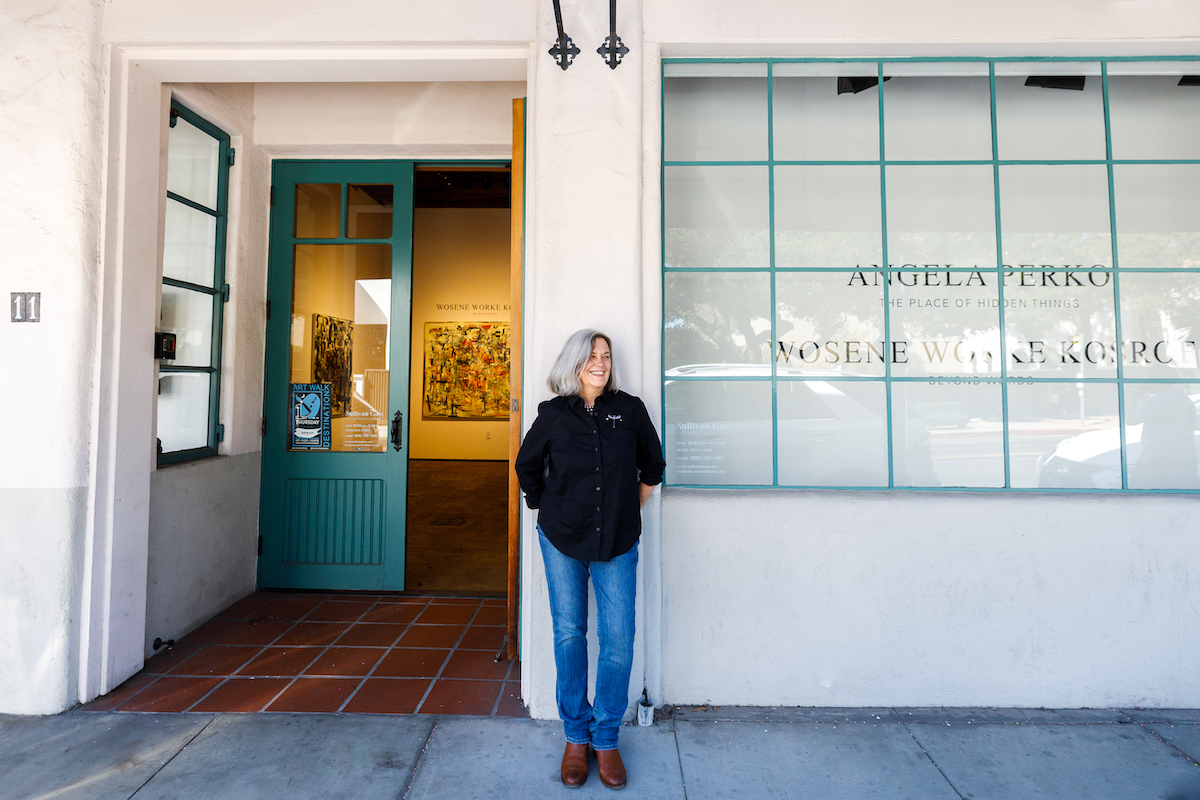
Art’s responsibility has always been to interpret experiences during trying times; it’s a worthy vessel for our collective remembrances, as well as our trauma. Could there be a more prescient and urgent display of artistic expression in Santa Barbara than Angela Perko’s current show at Sullivan Goss Gallery, The Place of Hidden Things? I doubt it.
Perko’s exemplary, focused, and cohesive collection of paintings speak loudly about pressing issues like the environment, and, most vividly, the challenges to women’s reproductive rights. Her visual and very sensitive handling of these subjects is portrayed in an enduring and classical manner recalling ancient art.
“I’ve always painted in a timeless fashion, but these works make contemporary statements,” the painter tells me. It is a staggering body of work by an artist at her most mature, disciplined, and visionary.

“There’s a lot of culture in her work,” says Susan Bush, curator at Sullivan Goss, An American Gallery. “In each of her paintings, there is such an influx of information from different cultures, from literature, and from myths. Angela has so much that she has to say; that she found an outlet for the things that she wants to say at a later stage in her life is brilliant.”
I’ve been a fan of Angela Perko’s work since the early 2000s, and I eagerly look forward to her exhibits; her work grows more complex and captivating with each show. Her paintings clamor for attention and exploration. There’s a lot of information in them, and they have a robust narrative that demands deciphering, but it also sweeps you up — you get lost in it. The first thing that strikes you is her bold and confident use of color. She combines landscapes with still life — universal imagery with mythology and history — submerging the viewer into a vernacular of Perko’s own creation. She intermingles all these different ideas at once in syncopated fashion — playfully mixing flat planes with foreground, mid-ground, and background. She coalesces observation and imagination in inimitable ways, frequently inserting emblems and unexpected elements and recontextualizing them within new or altered compositions that retain rigor and necessity. This results in paintings that are as physically palpable and ocularly layered as our complicated lives. Not only are our minds engaged, but our hearts are moved as well. Perko’s work requires the viewer to balance at least two contending ideas — the subject being displayed and the medium creating it.
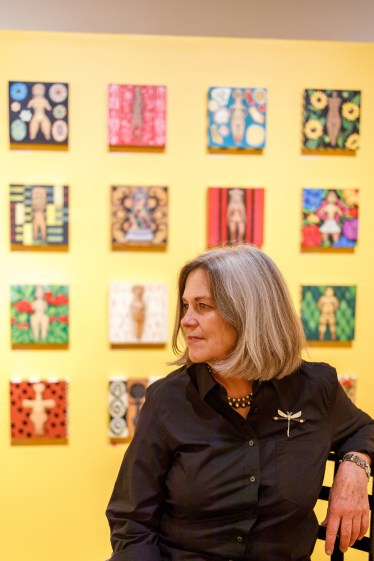
“I want to get away from too much narrative,” she explains. “I want the images to be accessible — universal. We’re part of the idea. Not necessarily telling the story but using universal imagery that could connect with the viewers.”
The other arresting aspect of Perko’s work is her introspection; this peek into her interior life seems to have deepened even further with her latest work. “I’m coming to terms with life,” she says. “I’m 64 years old. You start to reflect on your life. There’s fear. There’s a lot of loss in the world. I have grandchildren and worry about the future. This is part of working it out.”
Talking with Perko is inspiring, and I was fortunate to be welcomed into her home for three conversations. She is warm and thoughtful and a great storyteller, who often digresses yet always comes back full circle to the topic she started with. She often texted me after I left with further reflections and clarifications.
Since 1995, Perko and her husband, Jerry Jacobs, have lived in a spacious home on upper State Street, where a rundown old shed has been transformed into an art studio and the California native plant garden continues to evolve.
Born in Hollywood, Florida, after her parents’ divorce, she went to live with her father in the countryside in Orange Springs, Florida. “It made an impact,” she admits. “I went to a rural school. One class for each grade.” A teacher asked her class to do an art project on the Norwegian fjords. Only 8 years old, Perko relished the opportunity. She recalls taking an art class in high school but being more interested in philosophy. Her studies took her to Lake Forest College in Illinois and on to Florida Atlantic University in Boca Raton, where she took philosophy classes but was disillusioned with the fact that everyone else was asleep in them.
After college, she worked in a restaurant, met Jerry, and got married. “Our connection was that we both loved reading,” she says. “Both Jerry and I had nice libraries for people our age.”
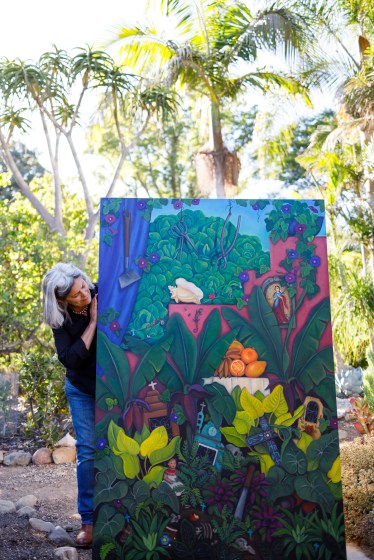
They knew people in the book business in San Diego and went with them on a road trip to Santa Barbara, their first glimpse of our town. Eventually, they decided to open their own bookstore and considered doing it in Florida but opted for California in 1981. “There were so many bookstores in S.B. at the time. This was a real book center,” says Perko.
Steven Acronico offered Jerry a job at Hammer Books — a rare bookstore — and Angela worked at the Charlotte Bakery in De la Guerra Plaza. They opened Lost Horizon bookstore in 1983, which was first located downtown and then moved to the Upper Village in Montecito in 2019, where they share the space with the Stewart Fine Art Gallery, which mixes nicely with the books.
“We always loved the book and the movie,” says Perko of the store name. “It stands as a place that preserved all Western culture and ideas, plus Ronald Coleman [star of the film] lived in Santa Barbara.” They did well from the beginning. “The bookstore is an interesting thing, for you never know what’s going to come your way,” she says. “We have a great collection of art books at the store. Jerry was always a collector. Booksellers have an enthusiasm for collecting.”
“I always say I’m a book-learned painter,” says Perko. She considers her stint at the bookstore as essential to her artistic career. It was there she became acquainted with the Canadian “Group of Seven,” artists (once known as the Algonquin School) who were at their peak in the 1920s-1930s and strongly
influenced by post-Impressionism, creating bold, vividly colored canvases. Perko, who is mostly self-taught, also learned a tremendous amount from studying the works of Kandinsky, Picasso, and many other artists from the early part of the 20th century. But it is the literary connections that make her paintings stand out, and they owe a lot to her immersion in the book world.
“I am very moved by visual writers, like Virginia Woolf,” she says. “The Waves and To the Lighthouse are two novels that I feel have greatly added to my visual vocabulary. Federico García Lorca, Jorge Luis Borges, and Pablo Neruda provide a visual feast. And scenes from Gabriel García Márquez’s works rattle around my head. Sor Juana Inés de la Cruz is my go-to for a feminine gaze, and, of course, Jane Austen. The very visual and sensitive handling of classical subject matter by David Malouf reinforces the idea of timelessness that I often attempt to achieve. Graham Greene is a favorite. I admire his questioning of his faith, and his sense of irony puts him high on my list of influences, along with Iris Murdoch and José Saramago.”
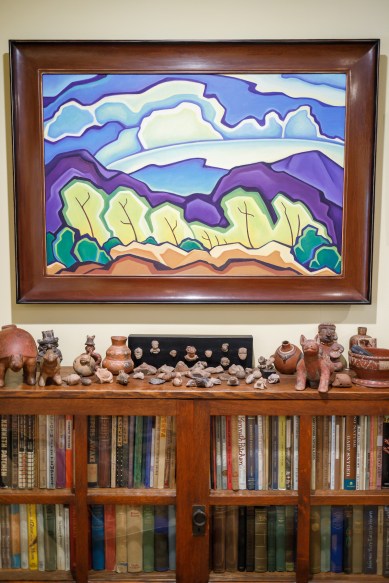
Perko didn’t start painting until 1988, when she took landscape lessons with Michael Drury. “The children were grown up,” she says. (Angela and Jerry have two daughters: Sara, who teaches art in the international school system in Istanbul and is soon moving to Argentina, and Tessa, who lives in Germany and has a doctorate degree in cultural studies.) “The bookstore was Jerry’s baby,” Perko says. “It’s his identity. Painting for me was just sort of like picking up the brush and finding out this is who I am. This is what I do.”
It was also at the Lost Horizon bookstore where Perko hung her first works, and where she was noticed by art gallery owner Maureen Murphy, who represented esteemed landscape painters like Ralph Waterhouse, Meredith Brooks Abbott, and Rick Garcia. “My paintings stuck out like a cold sore,” Perko says self-deprecatingly.
Murphy advised her, “Your stuff sells, but I can’t put them on the wall. You should look for somebody else to represent you.” Frank Goss, who founded Sullivan Goss, An American Gallery, and has since retired, saw Perko’s work at the bookstore and offered her representation. Her first show there was in 2005 — it was a success.
“The average person walking in the gallery is going to have to take some time to figure out her paintings,” says Bush, who started as a curator at Sullivan Goss just days before Perko’s first show opened. “They require scrutiny,” Bush continues. “They’re not easy retail paintings. They have a museum quality. We believe in her paintings.” Bush also shares that Perko’s pieces have a big following. “She has a few dedicated collectors,” she exclaims. “She’s garnered a following among writers and musicians. Her paintings are very rhythmic.”
In the midst of our conversations, the Supreme Court overturned Roe v. Wade. Perko and I had a planned follow-up meeting the day after, but we decided to reschedule since we were both so distraught. I got a text from her: “There’s been an unsettling increase in hostility toward women for a while now. I often wonder if that has been part of why I am compelled to tell my stories from a more feminine point of view. I want to highlight the absolutely essential but un-heroic part women play in a playful, serious way. One can’t help but ask, why is there such fear and anger, animosity, and, frankly, cruelty directed at women? … It’s an age-old question made more poignant with today’s ruling.”
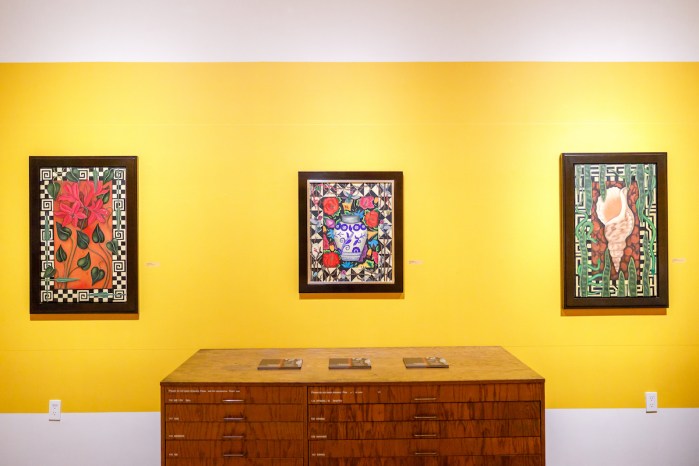
At the heart of Perko’s collection are a group of 17 small paintings (10″ x 10″), which she endearingly calls “the pretty ladies,” with each representing a fertility figure from different antiquity cultures (Greek, Egyptian, Japanese, and Mexican, among others.) She is thinking about women throughout the ages and how important they are in the fabric of life. She’s also showcasing them — giving them their own space and their due.
“What attracted me to them is that they’re diminutive women,” she says. “They’re so essentially feminine. Fertility is important in keeping life going. These figures are important to these cultures. It’s still so essential to the nature of women. They come alive when you examine them. So many expressions that you see in women today; they still speak in their own quiet voices.”

Each fertility figure is positioned against a contrasting and elaborate pattern in the background — both beautiful and kinetic. The backgrounds battle with the small-scale figures about who gets the most attention. The visual push and pull is dynamic. My interpretation is that Perko wants to illustrate that women are the ones who ultimately claim the spotlight in the portrait and not the pressures of society, history, and Supreme Court rulings. Perko has also painted three large-scale pieces measuring 60″ x 60″ — again depicting fertility figures. One is called “Lady of the Shells,” and the others are “The Two-Faced Woman From Tlatilco,” and “Lady of the Labyrinth.” They are gasp-inducing, defiant, and gorgeous. In this entire series, Perko is elevating an ordinary everyday effigy to the place they belong — a place of grace, beauty, and dignity, a place of art.
“What was striking about these fertility figures is that people believed in them,” she explains. “They’re magical. We don’t believe in them the same way anymore. They were used by women on an everyday basis. They were essential to women.”
“I don’t think my talent is exceptional in a technical sense or conceptual sense,” she humbly says. “I developed this skill to be able to tell my stories, to illustrate what goes through my head in a visual way. They’re visual expressions of a literary nature. I think of myself as a poet or a short-story writer.” Six other canvases in the show are rich in imagery and magical realism storytelling about subjects such as the environment, justice, and fate — and recalling medieval illuminated manuscripts. She includes a checkered pattern around the border of the compositions that serves as an organizing component, giving structure and continuity to the series. The black-and-white patterns create a frame-within-a-frame motif. It provides a visual transition between the painting’s interior and its exterior subjects — or is it the other way around? “The frame defines an interior space, but I wanted nature to infringe upon it,” she elucidates. “It’s hopeful. We’re dependent on nature. It’s a play of inside/outside and trying to blur the lines.”
After I had left her house the last time, I received one of her texts: “I can only hope that my paintings give the viewer a moment of thought, or pleasure, or amusement, and perhaps that same viewer might discern something of themselves that they would not have otherwise seen.”
The Place of Hidden Things is on view at Sullivan Goss (11 E. Anapamu St.) through September 26. The gallery will host a free artist discussion with Angela Perko and Roger Durling on Saturday, September 10, at 4 p.m. Expect a lively, interesting conversation, and refreshments will also be provided. For more information, visit sullivangoss.com.
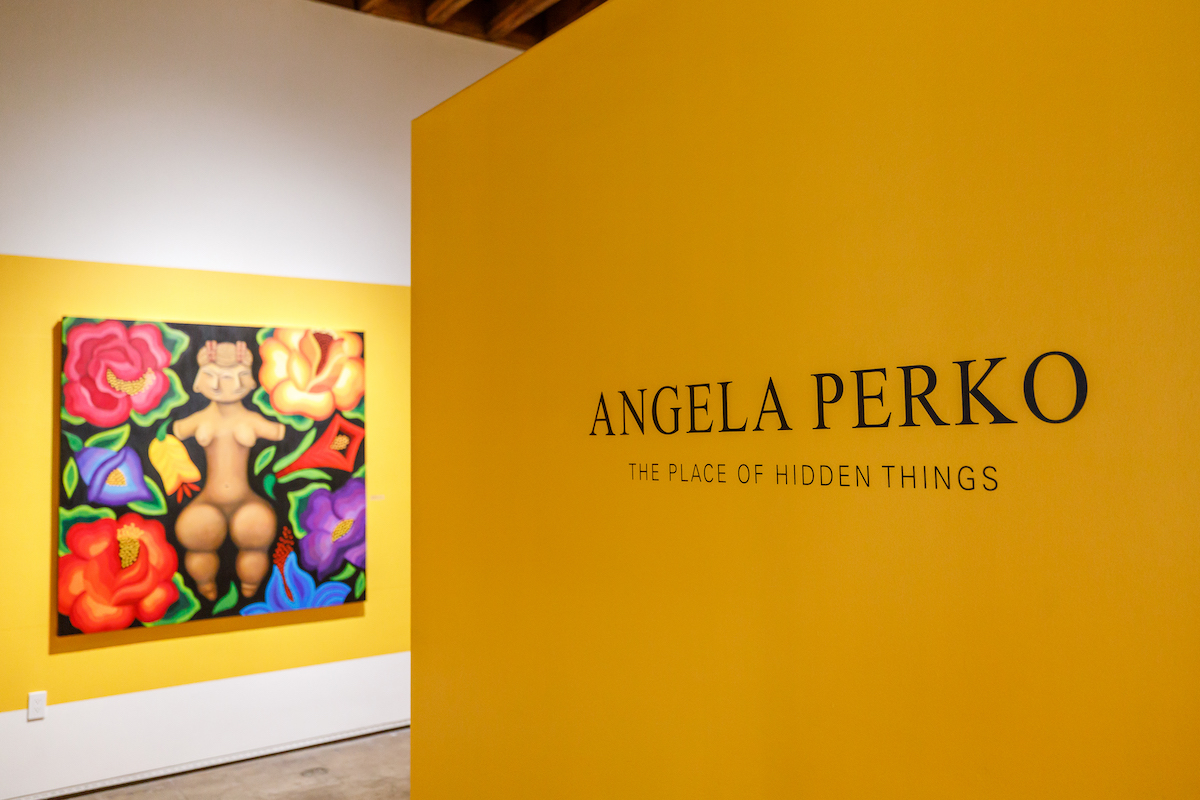




You must be logged in to post a comment.